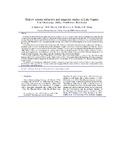Shallow seismic refraction and magnetic studies at Lake Ngami, The Okavango Delta, Northwest Botswana

View/
Date
2007Author
Laletsang, K.
Modisi, M.P.
Shemang, E.M.
Moffat, L.
Moagi, O.R.
Publisher
Elsevier www.elsevier.com/locate/jafrearsciType
Published ArticleMetadata
Show full item recordAbstract
A seismic refraction analysis was carried out on data acquired on an 8.5 km profile at Lake Ngami, NW Botswana, to determine the
structure and stratigraphy underlying the lake. The seismic spread comprised a 48-channel seismograph with a 9.5 m receiver and source
spacing. The seismic source comprised 10 hammer blows on an aluminum plate, from which a vertical stack was recorded. The data were
processed with WinSismTM version 10 program using the intercept time method. A total field magnetic survey was also carried out along
the same line.
The seismic refraction profile shows a low velocity layer (400–1600 m/s) extending from the surface at the southern end of the line to a
maximum depth of 30 m in the middle of the profile, returning to a depth of 20 m from 4.5 km to the northern end of the line. The low
velocity layer consists of the unconsolidated sediments and is underlain by more compact and saturated material with seismic velocities of
1600–3600 m/s. This material is interpreted to comprise semi- to fully consolidated sandstone. The base of these sandstones, however,
could only be mapped near the southern end of the line out to 2 km. High seismic velocity rocks (3600–5000 m/s), interpreted to be
weathered to fresh basement, were mapped below the sandstones at the southern end of the line.
The magnetic profile shows a high at the beginning of the line which progressively declines to a low at 3 km. The field strength
increases rapidly over the next 1.5 km to reach a plateau level at 4.5 km. The magnetic high at the beginning of the line corresponds
to shallow basement which is mapped in the refraction profile. The magnetic low at 3 km is indicative of a thickened sediment section
at this location.
The southern end of the line with high seismic velocities comprises basement rocks located in the footwall block of the Kunyere Border
Fault of the Okavango Rift. The step-wise downthrown hanging wall block consists of the low to intermediate velocity basin deposits
in the northern part of the profile.
